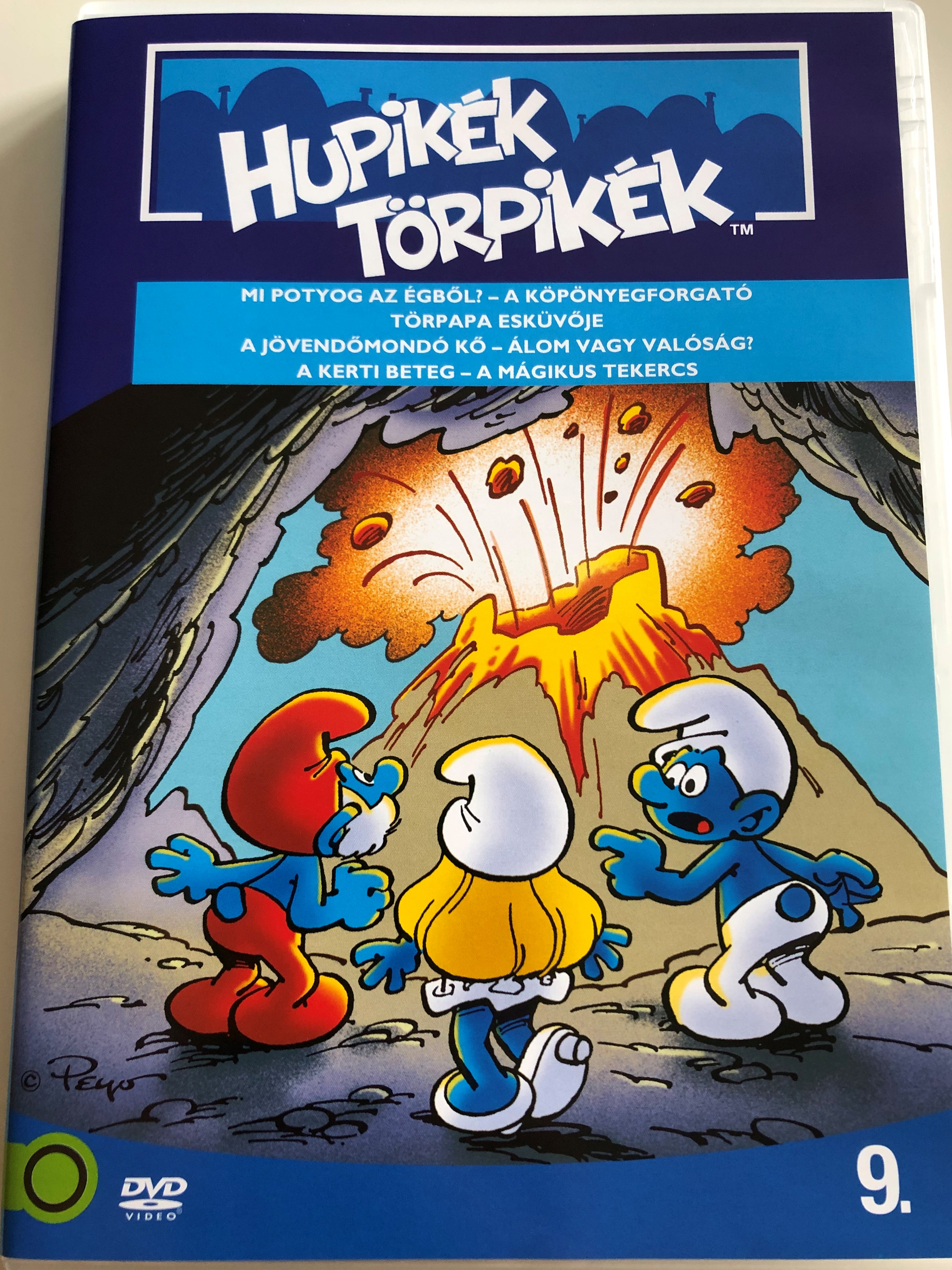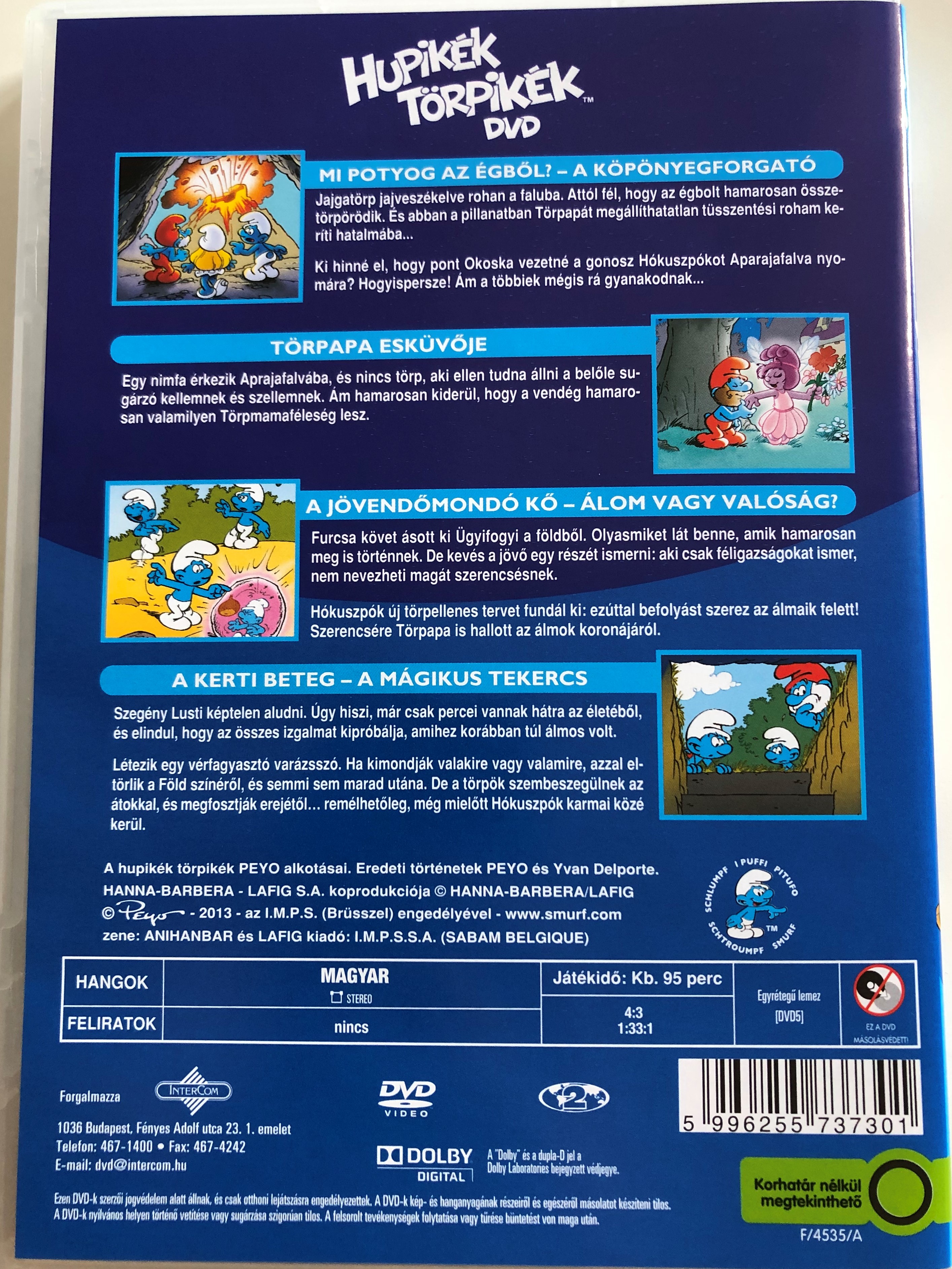Description
Hupikék Törpikék 9. / The Smurfs (1990) - DVD
UPC: 5996255737301
Overview:
Hupikék Törpikék 9. (English: The Smurfs 9) brings another delightful collection of seven episodes from the beloved animated series The Smurfs. Directed by José Dutillieu and George Gordon, this DVD features episodes like Mi potyog az égből, Törpapa Esküvője, Álom vagy Valóság, and A Kerti beteg. The Smurfs continue their magical adventures, from dealing with falling objects from the sky to celebrating Törpapa’s wedding and more. A fun-filled, heartwarming collection, this DVD is perfect for fans of the show and families who enjoy animated entertainment.
Product Features:
- Format: PAL DVD
- Region: 2
- Total Runtime: 95 minutes
- Audio Options: Hungarian 2.0
- Subtitles: None
- Made in: Hungary
- Studio: Hanna-Barbera
- Episodes Included:Genre: Animation, Family, Comedy
- Mi potyog az égből
- Törpapa Esküvője
- Álom vagy Valóság
- A Kerti beteg
- Additional episodes included
- Language: Hungarian
- Cover Art: Features scenes of the Smurfs engaging in various magical activities, with vibrant colors and classic animation style that fans love.
Interesting Facts:
- The Smurfs (originally Les Schtroumpfs) was created by Belgian cartoonist Pierre Culliford (Peyo) in 1958. The series has remained a global favorite, with TV shows, films, and merchandise.
- This Hungarian edition, Hupikék Törpikék, has been a staple of Hungarian children’s TV since its original airing in the 1980s, providing wholesome and entertaining episodes.
- Directed by José Dutillieu and George Gordon, these episodes continue the Smurfs’ adventures with humor and magical moments that are both entertaining and educational.
- The Smurfs emphasize important values such as friendship, teamwork, and resilience, making it a great show for young audiences.
- Hupikék Törpikék 9. contains some of the most iconic Smurf moments, including an episode about Törpapa’s wedding and another where the Smurfs face strange falling objects from the sky, highlighting the fun and magical world of the Smurfs.
Publishers:
- Publisher: Hanna-Barbera
- Studio: Hanna-Barbera Productions
- Language Adaptation: Hungarian
- Release Date: 1990
- Made in: Hungary
We value your feedback! Share your experience with this product to help others make informed decisions. Your review is important to us!
Hashtags:
#TheSmurfs #HupikékTörpikék #HungarianAnimation #SmurfsDVD #HannaBarbera #AnimationForKids #FamilyDVD #ClassicCartoons #SmurfsEpisodes #HungarianTelevision #SmurfsAdventure #AnimationClassics #HungarianFamilyDVD #AnimationSeries
Hungarian Translation Section
Overview / Összefoglaló:
A Hupikék Törpikék 9. DVD-n hét újabb epizód található a népszerű Törpikék sorozatból. A rendezők, José Dutillieu és George Gordon vezetésével a Mi potyog az égből, Törpapa Esküvője, Álom vagy Valóság, és A Kerti beteg epizódok követhetők. A Törpikék új kalandokba vágnak bele, miközben megtapasztalják, mi potyog az égből, és Törpapa esküvőjét is ünneplik. A szórakoztató és szívmelengető epizódok ideálisak minden Törpikék rajongónak és a családoknak, akik szeretnének egy kis varázslatos kalandot.
Interesting Facts / Érdekes Tények:
- A Törpikék (eredetileg Les Schtroumpfs) 1958-ban született Pierre Culliford (Peyo) belga képregényrajzoló tollából, és világszerte ismertté vált.
- A magyar változat, a Hupikék Törpikék, először az 1980-as években jelent meg Magyarországon, és azóta is kedvelt mesefilm.
- A DVD-n szereplő epizódok a Törpikék kalandjait követhetik, ahogy különféle kihívásokkal néznek szembe, segítenek barátaiknak, és leküzdik Gargamel gonosz terveit.
- José Dutillieu és George Gordon rendezésében minden epizód szórakoztató és tanulságos történeteket tartalmaz a barátságról, hűségről és a jóról.
- Hupikék Törpikék 9. tartalmazza a legjobb Törpikék pillanatokat, köztük Törpapa esküvőjét, és azt, hogy mi történik, amikor valami potyog az égből.
Hashtags / Hashtagek:
#Törpikék #HupikékTörpikék #MagyarAnimáció #SmurfsDVD #HannaBarbera #CsaládiDVD #KlasszikusRajzfilmek #TörpikékEpizódok #MagyarTelevízió #AnimációsKlasszikusok #CsaládiSzórakozás #RajzfilmekGyerekeknek
Episodes on DVD:
1. Mi potyog az égből? / The Sky Is Smurfing!
2. A köpönyegforgató / Turncoat Smurf
3. Törpapa esküvője / Papa's Weding Day
4. A jövendőmondó kő / Clumsy Smurfs the Future
5. Álom, vagy valóság / The Stuff Dreams Are Smurfed Of
6. A kerti beteg / Smurf Me No Flowers
7. A mágikus tekercs / The Kaplowey Scroll
The storylines tend to be simple tales of bold adventure. The cast has a simple structure as well: almost all the characters look essentially alike—mostly male (a few female Smurfs have appeared: Smurfette, Sassette, and Nanny Smurf), short (three apples high),with blue skin, white trousers with a hole for their short tails, white hat in the style of a Phrygian cap, and sometimes some additional accessory that identifies a personality (for example, "Handy Smurf" wears overalls instead of the standard trousers, a brimmed hat, and a pencil above his ear). Smurfs can walk and run, but often move by skipping on both feet. They love to eat sarsaparilla (a species of Smilax) leaves, whose berries the Smurfs naturally call "smurfberries" (the smurfberries appear only in the cartoon; in the original comics, the Smurfs only eat the leaves from the sarsaparilla).
The Smurfs fulfill simple archetypes of everyday people: "Lazy Smurf", "Grouchy Smurf", "Brainy Smurf", and so on. All Smurfs, with the exception of Papa, Baby, Smurfette, Nanny and Grandpa, are said to be 100 years old. There were originally 99 Smurfs, but this number increased as new Smurf characters appeared, such as Sassette and Nanny. All of the original Smurfs were male; later female additions are Smurfette and Sassette—Smurfette being Gargamel's creation, while Sassette was created by the Smurflings.
Language
A characteristic of the Smurf language is the frequent use of the undefinable word "smurf" and its derivatives in a variety of meanings. The Smurfs frequently replace both nouns and verbs in everyday speech with the word "smurf": "We're going smurfing on the River Smurf today." When used as a verb, the word "Smurf" typically means "to make", "to be", "to like", or "to do".
Humans have found that replacing ordinary words with the term "smurf" at random is not enough: in one adventure, Peewit explains to some other humans that the statement "I'm smurfing to the smurf" means "I'm going to the wood", but a Smurf corrects him by saying that the proper statement would be "I'm smurfing to the smurf"; whereas what Peewit said was "I'm warbling to the dawn". So "I'm smurfing to the smurf" is not the same as "I'm smurfing to the smurf".
In the animated series, only some words (or a portion of the word) are replaced with the word "smurf". Context offers a reliable understanding of this speech pattern, but common vocabulary includes remarking that something is "just smurfy" or in some cases, "smurftastic".
In Schtroumpf vert et vert Schtroumpf (see Smurf Versus Smurf), published in Belgium in 1972, it was revealed that the smurf village was divided between North and South, and that the Smurfs on either side had different ideas as to how the term "smurf" should be used: for instance, the Northern Smurfs called a certain object a "bottle smurfer", while the Southern Smurfs called it a "smurf opener". This story is considered a parody on the still ongoing taalstrijd (language war) between French- and Dutch-speaking communities in Belgium.
Smurf village
When they first appeared in 1958, the Smurfs lived in a part of the world called "Le Pays Maudit" (French for "the Cursed Land"). To reach it required magic or travelling through dense forests, deep marshes, a scorching desert and a high mountain range. The Smurfs themselves use storks in order to travel long distances, such as to the kingdom where Johan and Pirlouit live, and keep up-to-date with events in the outside world.
In the Johan et Pirlouit stories, the Smurf village is made up of mushroom-like houses of different shapes and sizes in a desolate and rocky land with just a few trees. However, in the Smurf series itself, the mushroom-like houses are more similar to one another and are located in a clearing in the middle of a deep forest with grass, a river, and vegetation. Humans such as Gargamel are shown to live nearby, though it is almost impossible for an outsider to find the Smurf village except when led by a Smurf.
Smurf economy
The Smurfs' community generally takes the form of a cooperative, sharing, and kind environment based on the principle that each Smurf has something they are good at, and thus contributes it to Smurf society as they can. In return, each Smurf appears to be given their necessities of life, from housing and clothes to food without using any money in exchange.
| Created by | Peyo |
|---|---|
| Original work | "The Flute with Six Holes" (French: "La Flûte à six trous") (1958) in comic Johan and Peewit |
| Print publications | |
| Comics | The Smurfs comics |
| Films and television | |
| Film(s) | The Smurfs in film |
| Animated series |
|























